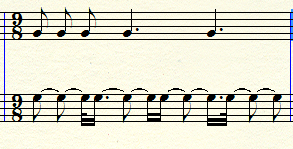A consideration that no one else has mentioned is that this type of figure is often used around tempo changes. If that is the case, it will be hard to coordinate everyone (depending on proficiency) and is counterproductive to spend a lot of time working on getting the rhythm exactly accurate (since it will be in flux anyway). Rehearsal time is better spent "feeling" the rhythm together.
Assuming that this is a spot where the tempo remains steady and it's not a rubato/soloistic passage:
The rhythms we encounter can often be simplified conceptually in another meter - 3/2 = dotted notes in 3/4, etc. A hemiola like this that is split into a triplet really can't be simplified; no matter what you're going to have at least two layers of cross rhythm going on, which is too much for my brain to decode.
In case it helps you, 9/4 can be "simplified" as 32nd notes in 9/8. The 9 can be thought of as 8th notes and the 4 can be thought of as groups of nine 32nds, like this:

This rhythm is quite complex and going to be hard to think of in those terms. If that doesn't work for you, try another approach.
My general guidelines are:
Find a spot for your internal metronome where you can feel the base rhythms. Start it clicking a few measures before the trouble passage, and keep it going a few measures after to make sure you hold on to the tempo.
Break the rhythm down into simpler patterns ("check patterns"), then rebuild it.
In this case, I'd choose to set my internal metronome to half notes. For practice, I'd use an external (real) metronome also set to half notes.
For the first simplified rhythm, I'd do the three half note triplet. 3/2 is not too hard, so it shouldn't take you too long to be able to play G C B in the right rhythm in context.
Next, I'd take the inner triplet and the C, so you play G A B C, and hold the C. Learn to do this in context, and alternate between the previous pattern and this pattern to ensure that the key notes sound the same relative to the metronome (still on half notes).
After that, the whole rhythm should come together pretty well. Always practicing with the metronome on half notes will keep you firmly in duple-land, and is easy to switch between 4 and 9. Depending on tempo, you might even think in 1 (metronome to whole notes), but the fact that it's notated in 4 makes me think it won't be that fast.




